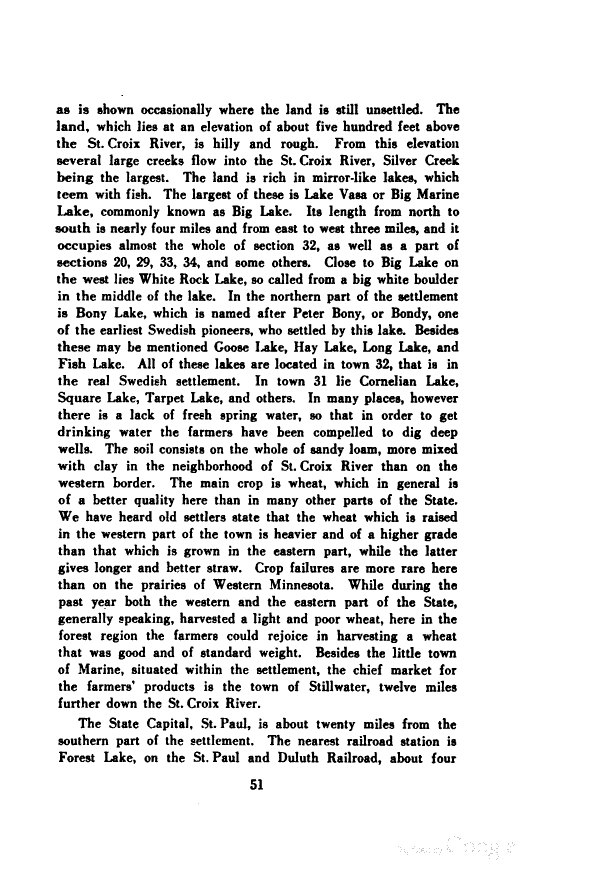
Full resolution (TIFF) - On this page / på denna sida - Sidor ...

<< prev. page << föreg. sida << >> nästa sida >> next page >>
Below is the raw OCR text
from the above scanned image.
Do you see an error? Proofread the page now!
Här nedan syns maskintolkade texten från faksimilbilden ovan.
Ser du något fel? Korrekturläs sidan nu!
This page has been proofread at least once.
(diff)
(history)
Denna sida har korrekturlästs minst en gång.
(skillnad)
(historik)
as is shown occasionally where the land is still unsettled. The
land, which lies at an elevation of about five hundred feet above
the St. Croix River, is hilly and rough. From this elevation
several large creeks flow into the St. Croix River, Silver Creek
being the largest. The land is rich in mirror-like lakes, which
teem with fish. The largest of these is Lake Vasa or Big Marine
Lake, commonly known as Big Lake. Its length from north to
south is nearly four miles and from east to west three miles, and it
occupies almost the whole of section 32, as well as a part of
sections 20, 29, 33, 34, and some others. Close to Big Lake on
the west lies White Rock Lake, so called from a big white boulder
in the middle of the lake. In the northern part of the settlement
is Bony Lake, which is named after Peter Bony, or Bondy, one
of the earliest Swedish pioneers, who settled by this lake. Besides
these may be mentioned Goose Lake, Hay Lake, Long Lake, and
Fish Lake. All of these lakes are located in town 32, that is in
the real Swedish settlement. In town 31 lie Cornelian Lake,
Square Lake, Tarpet Lake, and others. In many places, however
there is a lack of fresh spring water, so that in order to get
drinking water the farmers have been compelled to dig deep
wells. The soil consists on the whole of sandy loam, more mixed
with clay in the neighborhood of St. Croix River than on the
western border. The main crop is wheat, which in general is
of a better quality here than in many other parts of the State.
We have heard old settlers state that the wheat which is raised
in the western part of the town is heavier and of a higher grade
than that which is grown in the eastern part, while the latter
gives longer and better straw. Crop failures are more rare here
than on the prairies of Western Minnesota. While during the
past year both the western and the eastern part of the State,
generally speaking, harvested a light and poor wheat, here in the
forest region the farmers could rejoice in harvesting a wheat
that was good and of standard weight. Besides the little town
of Marine, situated within the settlement, the chief market for
the farmers’ products is the town of Stillwater, twelve miles
further down the St. Croix River.
The State Capital, St. Paul, is about twenty miles from the
southern part of the settlement. The nearest railroad station is
Forest Lake, on the St. Paul and Duluth Railroad, about four
<< prev. page << föreg. sida << >> nästa sida >> next page >>